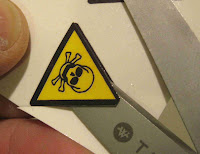I thought this kit had water slide decals, but it's got the "peel and stick".
I would have preferred the water slide.
Right out of the bag these decals had wrinkles and lifted areas on the sheet.
Even though Quest recommends Testors 1210 Bright Blue paint, I didn't want to risk the paint not matching the blue on the stick on sheet.
While other parts were drying, I decided to do a scan and redraw if needed.
The backing paper was a light yellow. I needed a bright white background for a clean scan.

The decals were transferred onto some 110 lb. card stock.
I was careful not to touch the sticky backs and get dirty fingerprints on them. I used the tip of a knife to lift and stick them down to the card stock.
Here's all the decals stuck on the card stock.
I shouldn't say "all" of the decals. After reading JeffyJeep's comments on TRF (after he finished an Aerospace One Build) I've decided to mask and spray all the blue trim.
The decals on the left are everything except the larger blue trim pieces and the white "Aerospace One" name decals. I can't print white on my ink jet printer.
The scan was loaded into Corel Draw. I ended up redrawing everything.
A presidential seal was found online and adjustments were made to the closest font I could find. On the launcher, no one will notice the difference.
January 17, 2013
I just got an email from Bill Stine.
I asked his permission to make the Aerospace One decal sheet available. He gave the okay to send it out!
Patreon members: If you'd like a PDF of the Aerospace One "print it yourself" decal sheet, email me at: oddlrockets@bellsouth.net
Please note: The available decal art is the property of Quest Aerospace and used by permission.
The decal art is not of the larger blue trim pieces. As mentioned earlier, I masked and spray painted the blue areas.



















































